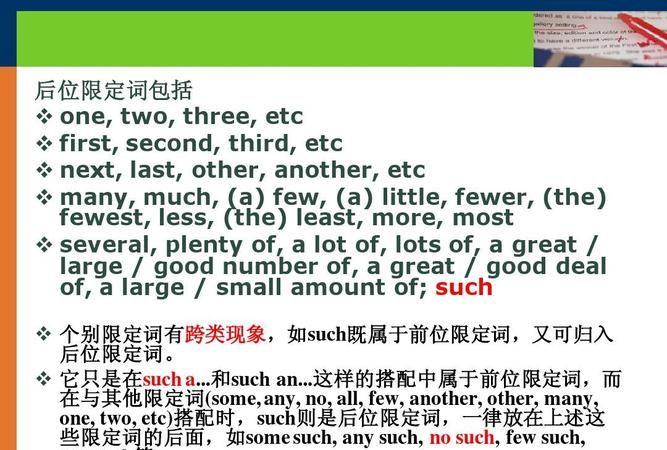本文目录
英语限定词的使用规则是什么意思
限定词的顺序口诀7个字:
一、限:限定词。the, my, a, this。
二、描:描绘性形容词。brave, beautiful, lovely, nice。
三、大:大小、高低、长短等形容词。big,large,small。

四、形:形状。round,square。
五、龄:年龄大小、新旧、年代等。young,old,new。
六、颜:颜色。red,blue,green。
七、籍:国籍、地区、出处。Chinese,America,Japanese。
英语中限定词有什么顺序吗
限定词的顺序口诀7个字:
限:限定词。the, my, a, this…
描:描绘性形容词。brave, beautiful, lovely, nice…
大:大小、高低、长短等形容词。big,large,small…
形:形状。round,square…
龄:年龄大小、新旧、年代等。young,old,new…
颜:颜色。red,blue,green…
籍:国籍、地区、出处。Chinese,America,Japanese…
物:物质材料的形容词。golden,wooden,wax…
类:表示类别、用途。medical,chemical,writing…

扩展资料:
按照限定词与限定词的相互搭配关系,限定词可分为前位限定词(pre-determinative)、中位限定词(central determinative)和后位限定词(post-determinative)。
限定词的相互搭配关系为:前位+中位+后位
在这三类限定词中,前位限定词与前位限定词以及中位限定词与中位限定词是相互排斥的,后位限定词与后位限定词之间虽不相互排斥但有搭配限制。
英语中修饰不可数名词的词或者短语
首先要搞清楚,是修饰可数名词或不可数名词,而不是单数或复数名词。可数名词都有复数形式,而不可数名词没有复数形式。
a large deal of、a plenty of和a good supply of 在多数情况下修饰不可数名词,如:a plenty of water, a geat deal of time,不过它们也可以修饰可数名词,如a plenty of men。
a quantity of在多数情况下修饰可数名词,如a quantity of boxes, 不过也可修饰不可数名词,如a quantity of milk。
quantities of与上述的一样
一、只能修饰可数名词的词语有:
many, many a(n), a good / great many, a (great / large) number of, scores of, dozens of等。例如:
Scores of people went there in the first few days after its opening.
开张后的头几天,很多人去了那儿。
I have been there dozens of times.
我已去过那儿很多次了。
There’re a number of students reading English in the classroom.
教室里有许多学生在读英语。
Many a student has(=many students have)visited the Great Wall.(谓语动词用单数)
很多学生都游览过长城。
In winter, a good many animals sleep under the snow.
冬天很多动物在雪下冬眠。
注意: many所修饰的复数名词前若有限定词,many 后面要接of, 表示“……中的很多”。 例如:
A great many(of the) graduates have found jobs.
毕业生中很多人已经找到了工作。
二、只能修饰不可数名词的词语有:
much, a great deal of, a great / large amount of等。例如:
Is there much water in the bucket?
桶里有很多水吗?
He always has a great amount of work to do.
他总是有很多工作要做。
三、既能修饰可数名词又能修饰不可数名词的词语有:
a lot of, lots of, plenty of (以上三个词语后谓语动词的数依of 后的名词的单复数而定),a great / large quantity of (其后谓语用单数),quantities of (其后谓语用复数)。例如:
There is still lots of snow in the garden.
花园里还有许多雪。
There is plenty of rain here.
这儿的雨水很多。
A great quantity of flowers was placed in the hall.
大厅里放了很多鲜花。
There are large quantities of food in the cupboard.
橱柜里有许多食物。
在所有这些表示“很多”的词语中many, much 是最常用的词,它们既可以用于肯定句,也可以用于疑问句和否定句。例如:
Are there many people in the street?
街上有很多人吗?
There isn’t much time left.
剩下的时间不多了。
其它的词语都用于肯定句,日常会话中常用lots of, a lot of 或plenty of; 正式文体中常用 a great many, a (large) number of, a great deal of, scores of 或 dozens of 等。但若肯定句中有too, so, as, very或how 等词修饰时,则必须使用 many, much。例如:
The number of the people who lost their homes reached as many as 250,000.
无家可归的人数多达250,000人。
There is too much work to do.
要做的工作太多了。

限定词有哪些
限定词包括但不限于:
(1)Articles 冠词:
冠词是一种限定词,有a, an,和the. 使用冠词的基本原则是a/an用来修饰我们第一次提到的名词。
(2)Demonstrative Pronouns 指示代词:
指示代词是this, that, these和those。这些词后面接名词时是限定词,代替名词词组时是代词。
(3)Quantifier 数量词:
当我们想要描述多少时,用数量词放在名词前。常用的数量词有many, all, no, none, lots of, a few, a number of, plenty of, any, some, a bit, much. 有些数量词只能修饰不可数名词,有些只能修饰可数名词,有些不可数和可数名词都能修饰。
(4)Possessive Adjectives 物主形容词:
当我们要描述某物属于某人或者我们正在谈论的人时,我们使用物主形容词。单一的物主形容词包括my, your, his, her, its.复数物主形容词包括our, your and their。

英语中的“限定词”介绍:
限定词是一种比较常见的词类,对应的英文名称是determiner,在字典上常被缩写为det.或DET。限定词常出现在名词词组的开头位置,用于限定所用的名词或名词词组。
然而,与传统的词性概念(如冠词、代词、形容词等)相比,限定词可以看作是另一种分类方式的产物,它不属于遵从传统分类的十大词性,却根据其自身的用法,包含有部分冠词、代词、以及形容词等。
以上内容参考:百度百科-英语语法
以上就是关于英语限定词的用法,英语限定词的使用规则是什么意思的全部内容,以及英语限定词的用法 的相关内容,希望能够帮到您。
